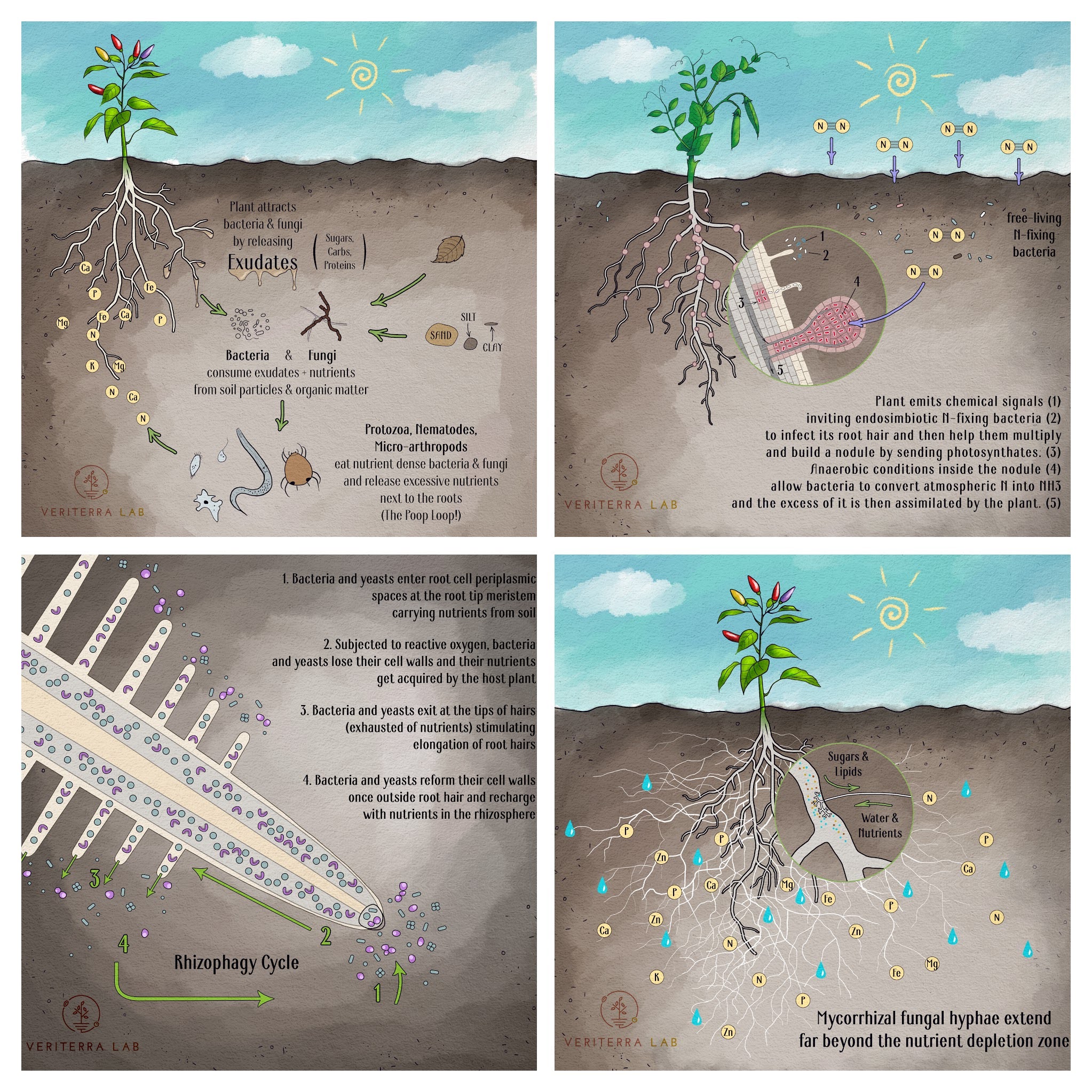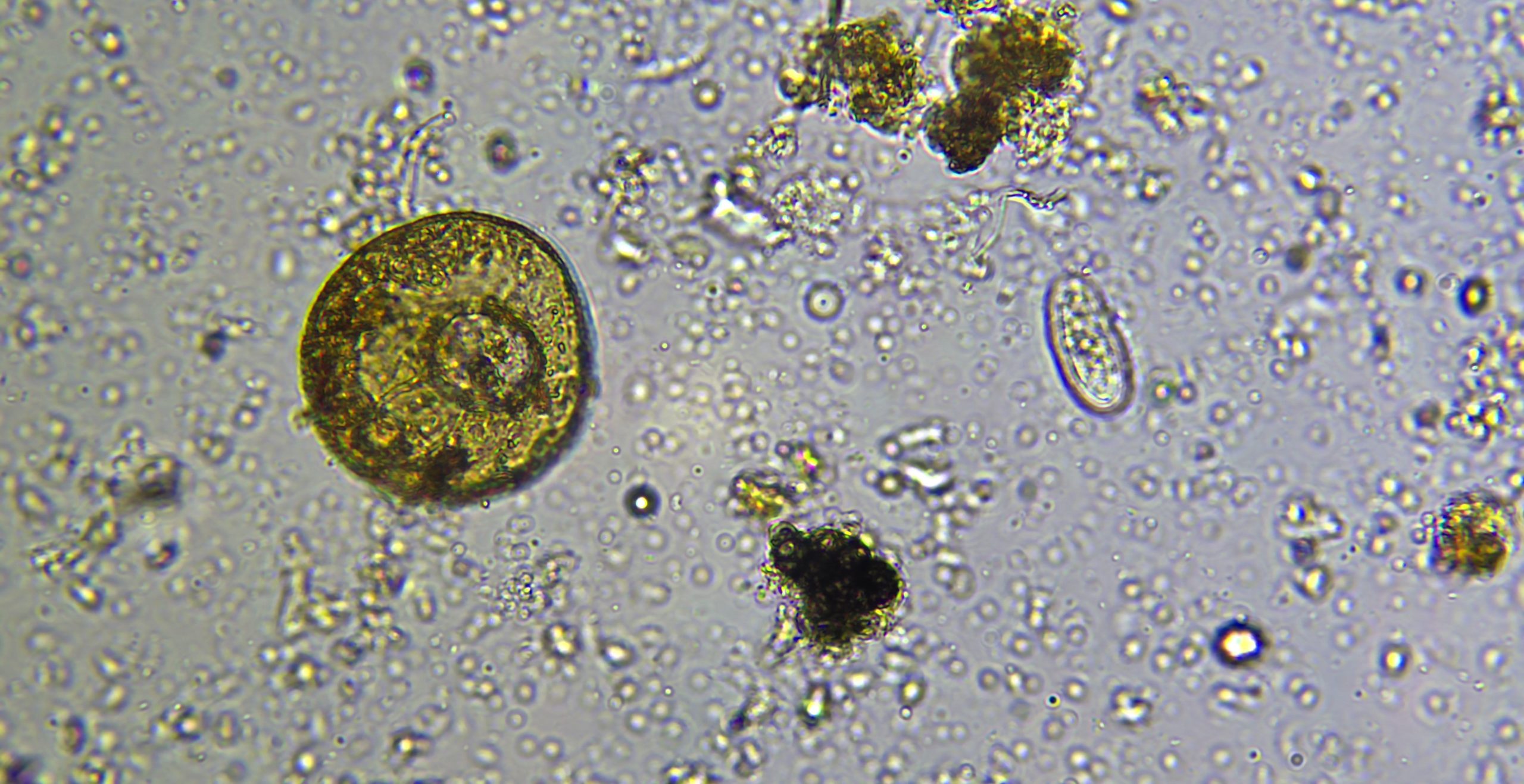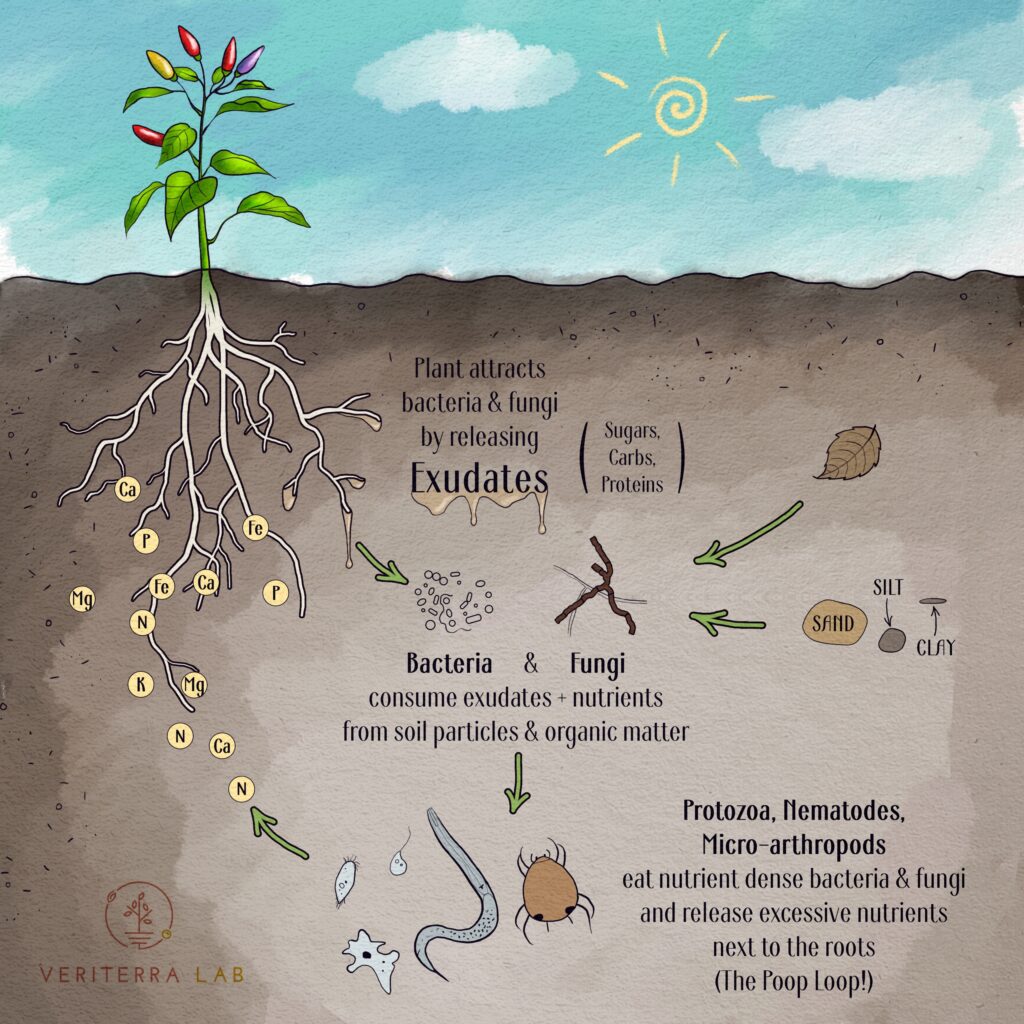
4 ways that soil microbes help plants obtain nutrients
It is more accurate to say that plants and soil microbes have developed mutually beneficial ways to exchange nutrients with each other. Plants have the

You probably heard that plant roots can take up inorganic soluble nutrients (e.g. nitrates, phosphates) directly from soil by diffusion. Sounds awesome, but it’s only half of the truth successfully exploited by fertilizer companies.
The other half is that plants intentionally attract and grow massive amounts of bacteria and fungi around the root surfaces, and those microorganisms can easily intercept and consume all the soluble nutrients diffusing to the root. However, plants still get all the nutrients they need if the complete Soil Food Web is present, without addition of any inorganic fertilizers. Here is how it works.
Plants invest up to 40% of their sugars, carbs, proteins and some other compounds into the soil to feed certain bacteria and saprophytic fungi. Bacteria and fungi need this easily-available energy source to be able to decompose organic matter and mineral particles and accumulate nitrogen and other nutrients in their bodies. In healthy soil predators of bacteria and fungi (e.g. protozoa & nematodes) will be attracted to the root zone by the large amounts of their prey and start consuming them. As concentrations of nutrients in bacteria and fungi are much higher than predators need, they will be pooping out those excessive nutrients right next to the roots, and plants can easily absorb them now!
See below my illustration of the Poop Loop part of the nutrient cycling happening in soil:

In healthy soil plants can get the exact amount and type of nutrients they need anytime by releasing specific root exudates to grow specific species of bacteria or fungi that will be eaten by protozoa, nematodes and microarthropods. They figured it all out for millions of years of evolution. We can’t really know what nutrients and how much each plant needs every second of every day. Moreover, man-made inorganic fertilizers usually contain a limited variety of nutrients (e.g. NPK) and lead to nutrient imbalances and bad flavor.
Fertilizers only work in degraded agricultural soils where after years of tilling, overgrazing and using toxic chemicals nothing’s left except bacteria. With complete Soil Food Web in place applying an inorganic fertilizer will make no difference on plant growth¹, but over time an excessive amount of inorganic fertilizers will break the connection between the plant and the Soil Food Web. Also, as inorganic fertilizers are salts, they take away water from plants, kill microorganisms and pollute everything downstream. In other words, nothing good, but the fertilizer industry makes billions of dollars on these products.
The fact that plant growth and nutrients uptake depends on predator-prey interactions has been proven back in the 80s. For example, in 1985 M.Clarholm reported that the N taken up by a wheat plant increased by 75% when protozoa were included into soil containing only bacteria² (the soil was first sterilized and then bacteria were reintroduced). Research of Dr. Elaine Ingham and other microbiologists on nematodes, plant growth and nutrient cycling³ also showed that after adding predators to the system production in plants has increased significantly.
Since then the benefits of restoring the Soil Food Web for plant health and productivity has been demonstrated numerous times in the field. See some examples from the Soil Food Web School website below.
At the same time, the amount of synthetic fertilizers used on farms worldwide has only increased since the 80s (and so has water pollution!).
Among some communities like regenerative ag, permaculture and indigeneous people the importance of soil life is widely recognized, but It’s not mainstream yet. The majority of conventional farmers are still suffering from increasing expenses on synthetic fertilizers (another uncool feature of fertilizers is that to get the same amount of yields the amount of fertilizer should be increased every year). Most agricultural universities and colleges teach only chemical agriculture. Here is an interesting article why that is the case.
“Over the past 30 years, as public funding for university research has dried up, private industry money has poured in. And with industry dollars comes industry priorities.”
https://thecounter.org/agriculture-industry-influence-money-academic-research/
Just because something is done by the majority doesn’t mean that it is the right and the only way.
Mother nature has been growing plants for about 500 millions of years without our fertilizers, but with the help of soil microorganisms, and so can we!
Beneficial soil microbes are providing plants with nutrients and doing other amazing things. I hope this blog post will help farmers and gardeners get a better understanding of ecological processes happening in soil and start teaming with those incredible microorganisms.
1. Work done by Dr. David Johnson (NMSU) showed that concentrations of soluble N, P, and K & Soil Organic Matter did not correlate with plant growth, but Fungal:Bacterial ratio correlated with plant growth.
2. Marianne Clarholm (1985). Interactions of bacteria, protozoa and plants leading to mineralization of soil nitrogen.
3. Ingham, R.E., J.A. Trofymow, E.R. Ingham and D.C. Coleman. (1985). Interactions of bacteria, fungi and their nematode grazers: Effects on nutrient cycling and plant growth. Ecological Monographs, 55:119-140.

It is more accurate to say that plants and soil microbes have developed mutually beneficial ways to exchange nutrients with each other. Plants have the

Last Saturday I held a workshop for volunteers at the Garden to Table Silicon Valley Farm. It was a great experience for me and so
Copyright © 2025 Veriterra Lab. All rights reserved
3 Responses
Great post! Looking forward to making a good environment in my soil for microbes, protazoa, nematodes, and all that good stuff. Any suggestions for easy to grow plants that provide root exudates to feed the microorganisms?
Thank you, Warren! That’s a great question. If you want to grow something edible I would recommend early successional plants (they don’t require lots of biology but set the stage for the plants later in succession) – things like lettuce, arugula, kale – personally I found them very easy to grow. Also perennial herbs are great because they can provide exudates for microbes year round and some of them are very hardy (oregano, thyme, sage, rosemary, tarragon, hyssop, lemon balm, chives). I would also try to grow alfalfa and use sprouts for food and the rest as “party food” for a compost pile. For covering soil I would plant perennial short growing cover plants as recommended by Dr.Elaine’s School (e.g. Arctostaphylos edmundsii Carmel Sur Manzanita, Horkelia Parryi, California Primrose, Creeping Thyme, Dichondra Repens, Mini Clover, Irish Moss, Creeping Speedwell etc). I hope this helps!
Thank you! I will plan on growing arugula, and will look into growing some of the perennial herbs you mentioned. I will also look into the groundcover plants you mentioned. Arctostaphylos edmundsii Carmel Sur Manzanita sounds nice, but it sounds like it doesn’t do well in full sun which my location mostly is. Still, I might try it. I’ll look for it at the nursery, when I am ready to plant. Maybe this fall.